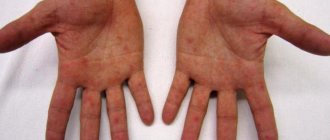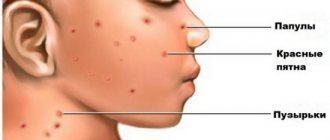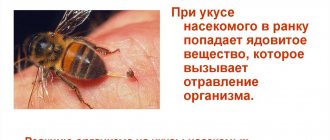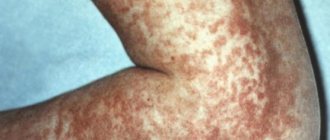When a rash appears in a child after a high fever, parents begin to look for the cause in the development of various diseases. Infections or other pathological conditions of the body do not always lead to problems. Excessive wrapping of the baby, exposure to allergens and other external factors can result in high fever and rash. In order not to harm the baby in each individual situation, you must be able to provide first aid to the child and independently recognize the disease.
Causes of rash in children with (and after) high fever
The causes of pathology should be divided into physiological and pathological. This will help you understand whether you should urgently seek medical help, what first aid measures you can take yourself at home when a child develops a rash after a high fever . You should also be able to distinguish the distinctive symptoms of each pathology.
The most common physiological factors include:
- Allergic reaction of the body. Pathology can be identified based on the main manifestations of the disease. The baby begins to develop a rash, localized throughout the body or at the site of contact with the irritant. The reaction may not always be accompanied by a high temperature; it may be absent. If it is present, you should pay close attention to the following symptoms. If a child’s throat begins to constrict, shortness of breath appears (even minor), the rash has a bright color and spreads throughout the body, there is swelling, you should immediately call an ambulance. Signs indicate Quincke's edema. The pathology can mainly be recognized with the help of antihistamines. Allergy symptoms should decrease or disappear altogether after taking drops of Fenistil, Zodek, Zyrtec, etc.
- Sweating. Almost 60% of parents have encountered this problem at least once, but not everyone knows that it can occur with elevated body temperature. You can recognize prickly heat in children by a specific rash. It manifests itself in the form of small or large spots, most often localized on the back, stomach, and neck. The disease is accompanied by itching, the child tries to comb the affected areas. Occurs after excessively wrapping the baby.
- An insect bite can be different, and therefore the reaction to it is different. Sometimes minor contact with a midge can lead to severe swelling and high fever. Particular attention should be paid to the bites of gadflies, bees, and wasps. It is easy to learn about pathology through swelling after contact with an insect, itching and burning. To reduce the risk of complications, it is necessary to take first aid measures in a timely manner.
Physiological factors are not as serious as pathological ones, but also require special attention from parents. A minor allergy to a food product or a midge bite can lead to dire consequences. All parents should know the main symptoms of the following diseases. They are often accompanied by high fever and are of a viral or bacterial nature:
- Rubella. A distinctive feature is considered to be enlarged lymph nodes in the back of the head and neck. The disease in 95% of cases means a high fever and the appearance of a small pink rash. The rashes are localized mainly throughout the body, but quickly disappear after a maximum of a week. Other symptoms may indicate a common cold, which often makes self-diagnosis difficult. Only with the appearance of a rash can parents guess the onset of rubella.
- Measles. At the beginning of the disease, parents confuse the disease with a cold, just as with rubella. This is due to the fact that the rash appears only after 3-4 days. The rashes look like small pink spots; they can be separated from each other or merge into a single whole. The disease is almost always accompanied by high fever. It may appear before or at the same time as the rash.
- Chicken pox is a serious pathology, dangerous with severe complications. It often begins with a high body temperature; the rash appears in the child immediately or within 2 days. The appearance of the rash differs from measles and rubella due to subsequent transformations. After a few days, the rashes begin to fill with clear liquid, then mature, become crusty and fall off. After some time, new ones appear.
- Meningococcal infection is a dangerous type of disease where a few hours can be decisive. The main symptoms are high body temperature, specific rashes (subcutaneous hemorrhages that look like stars), and vomiting. If these signs occur, you should immediately seek medical help.
- Scarlet fever. It manifests itself as a sharp jump in temperature up to 40 degrees. The child feels a severe sore throat, chills, and nausea. A significant sign helps to identify pathology - a white coating on the tongue in the first day and its further transition to the tonsils. Small pink rashes appear on the skin after about a day. For scarlet fever, it is important to start treatment on time, then you can avoid serious complications.
A bacterial or viral infection is always a very serious pathology that occurs with obvious symptoms. The main task of parents is not to miss the moment to help the baby.
Infectious causes of rash
When a rash appears on the body in the presence or after a high temperature, this indicates infectious pathologies.
Herpes types 6 and 7
The appearance of this type of virus often occurs in young children under 2 years of age due to an infectious disease. A rash in a child after a high fever appears after 2-3 days. It has a punctate character (roseola) and a red color, taking the form of multiple small pimples. It is localized first on the back and gradually spreads to other parts of the body. At the same time, the rashes are very itchy, which forces the child to scratch them.
Measles
In the presence of such a disease, a rise in temperature, cough and runny nose occurs. The appearance of a skin rash occurs on the 3-4th day. The lesions look like small red spots. They appear on the head, face and gradually localization spreads to the body and reaches the legs. The pathology is poorly tolerated, but is rare due to vaccination.
Rubella
When rubella occurs, a rash immediately appears, accompanied by signs of acute respiratory infections, and the lymph nodes localized on the neck and back of the head also enlarge. The rashes are small and pale pink in color. The increase in the affected area occurs similarly to measles, however, most rapidly in just 2-3 hours, and disappears after 4-5 days.
Chicken pox
The appearance of a rash after a high fever, as well as a deterioration in general condition, occurs due to chickenpox. The rash with this pathology consists of red spots localized throughout the body. Gradually they turn into blisters, inside of which there is a colorless liquid and itching appears. Then the contents become cloudy, and the pimple shrinks, dries out and disappears after a week. The appearance of such formations occurs up to 7 days. Chickenpox is most easily tolerated by children under 12 years of age; in adults it is much more severe.
What to do, how to cure?
When parents know exactly the causes of the rash and fever, we can talk about treatment methods. Self-therapy is allowed only in case of physiological, but not pathological problems. Insect bites should be treated with special pharmaceutical products in the form of ointments or sprays. Today, Fenistil gel and topical sprays are widely popular. They can relieve itching and help the baby calm down and relieve swelling after a bite.
An allergic reaction is initially treated by eliminating the harmful component that causes the unfavorable condition of the body.
If it is a food product, then you should not consume it further, powder - the chemical agent is changed and all things are washed. The child should be given an antihistamine.
In the case of prickly heat, you should monitor the room temperature and humidity; the baby should not feel stuffy. Air baths should be performed. Zinc-based ointments and Bepanten cream help well against heat rash. If a rash after a high fever is associated with infections, you should not self-medicate, as this can lead to serious consequences for the baby’s health.
A bacterial or viral infection should only be treated under specialist supervision. Therefore, at the first signs of damage, you must call an ambulance. You should not give your child medications or rub ointments on your own.
Measles and rubella
People without medical education often consider these two names to be synonymous. In fact, measles and rubella are two different conditions with different causes. Despite the fact that their symptoms are similar, treatment in both cases will be different.
Both rubella and measles cause a high fever and a rash on the body, including in adults.
Rubella symptoms:
- mild inflammation of the tonsils;
- redness of the posterior wall of the larynx;
- rashes are not typical in all cases;
- the rash, if it appears, is small and red;
- the temperature rises to 37-38 degrees.
The symptoms of measles are more serious, since it is a rather dangerous disease of an infectious nature:
- high temperature, fever, chills;
- rash all over the body;
- runny nose, lacrimation;
- cough;
- a sore throat;
- The first symptoms of measles resemble ARVI or flu.
Both diseases are quite serious and most often require hospitalization. It is better not to take risks and not to self-medicate - you should call an ambulance or see an infectious disease specialist.
If the cause of the rash and fever is an allergy
Allergic rashes can be caused by food products (fruits, fish, dyes, etc.), as well as allergens that surround us in everyday life (dust particles, wool, washing powder and many others). Allergic reactions often occur to medications and antibiotics.
Unlike an infectious rash, it does not cause any particular harm to the child’s condition (appetite is present and, with rare exceptions, there is no fever). If the rash is accompanied by swelling, especially in the face (lips, eyes), you should immediately consult a doctor, as this may be Quincke's edema or allergic shock. Spreading to the respiratory tract, swelling can lead to suffocation; in this condition, immediate hospital care or even intensive care is required.
By reviewing your child's diet and environment, you may be able to identify the cause of the allergy, but don't forget about multiple mosquito bites, which can sometimes be confused with a rash. The allergenic rash has a relief structure and appears unexpectedly, most often accompanied by a profuse runny nose, lacrimation and itching. It can also cover the entire body or individual areas, and is red in color and irregular in shape.
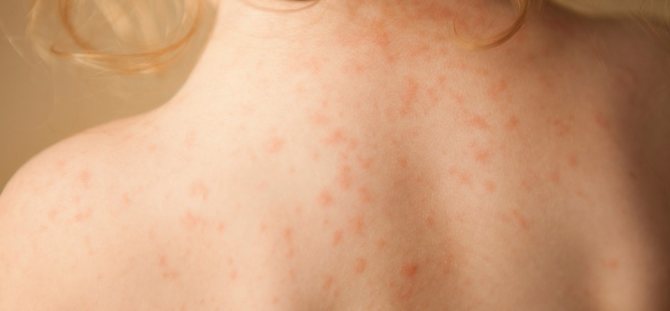
rash on the body of a child after fever
Sudden childhood exanthema or Roseola is a disease that Irisha just suffered from.
On Thursday morning she woke up with a fever. The child was burning.. You don’t need anything, just mom and just whine that your whole body is aching, fever and complete shit. It was possible to bring down such a wild temperature with antipyretics and rubbing with warm water and drying. Well, and the spells “Temperature, go away!!!” — where would we be without them)) The temperature remained so high for two days. It dropped to 37.5 and the child at least appeared in the mood and the desire to do something. By the end of the second day, a rash began. Wide, red, small. It started from the head and began to move down to the neck, back, stomach, arms, groin and a little to the legs. Once it broke out and we brought down the temperature, the temperature did not appear again. For the first day, the rash itched terribly in all places. I gave her an antihistamine and she felt better. After three days, the rash completely disappeared. The doctor confirmed Roseola.
For reference: a child is contagious during the incubation period (5-15 days) and when he has a fever. Moreover, it is contagious only for children. This virus does not affect adults. There is no need to treat roseola with anything. Only antipyretics as needed and only when the temperature goes off scale, i.e. high febrile (39.1-40.1). And an antihistamine to relieve wild itching. The appearance of a rash means that the disease has passed and the temperature will no longer rise.
I, as an armchair expert in the field of childhood rashes, have read and seen a lot more on this topic and was immediately sure that this disease a la “unknown shit happens to a child” is roseola. And not rubella, scarlet fever, measles, allergies or who knows what else. But our grandmothers know better... They put a million assumptions in my head that it was anything but roseola, because... There was no such disease before, we didn’t get sick like this, so they know better.. In short, it was roseola, although in terms of age it was already somehow late for it, and in general its seasonal exacerbation most often occurs in the spring and summer.
There are no other symptoms for roseola, except high fever in the first three days and a rash after.
By the way, I had information about roseola hanging somewhere in the subcortex. I learned about it, most likely from here, from BB - someone was sick and wrote. This was a hundred years ago, but somehow it was left in my mind that these were some manifestations. So when I saw the rash, I immediately went to Google roseola to refresh my memory of what to do with it.
5 days passed and on the 6th the child was already healthy and she was calmly released into kindergarten after a doctor’s examination.
Do not be ill! Clean skin and no fever to everyone!

